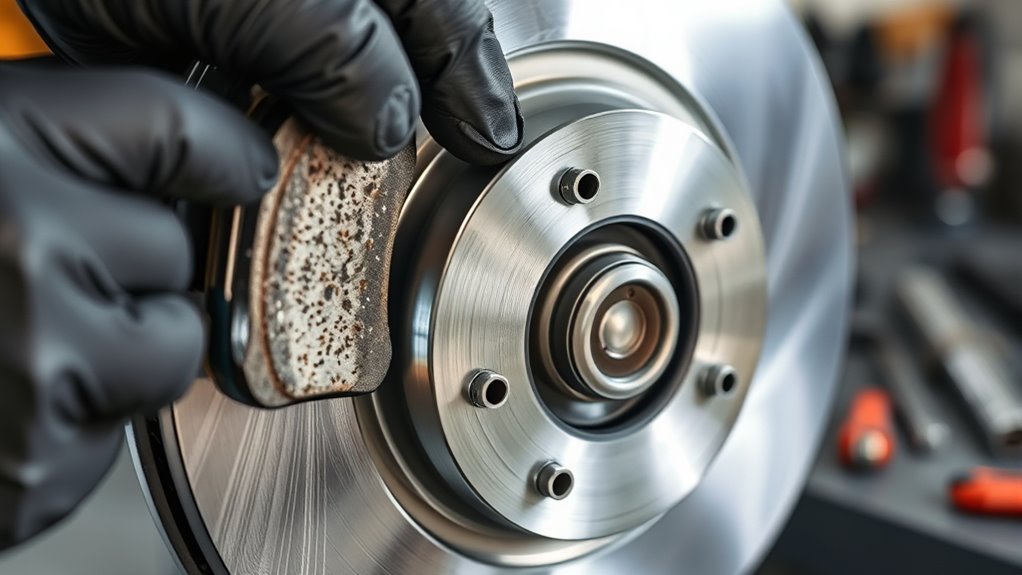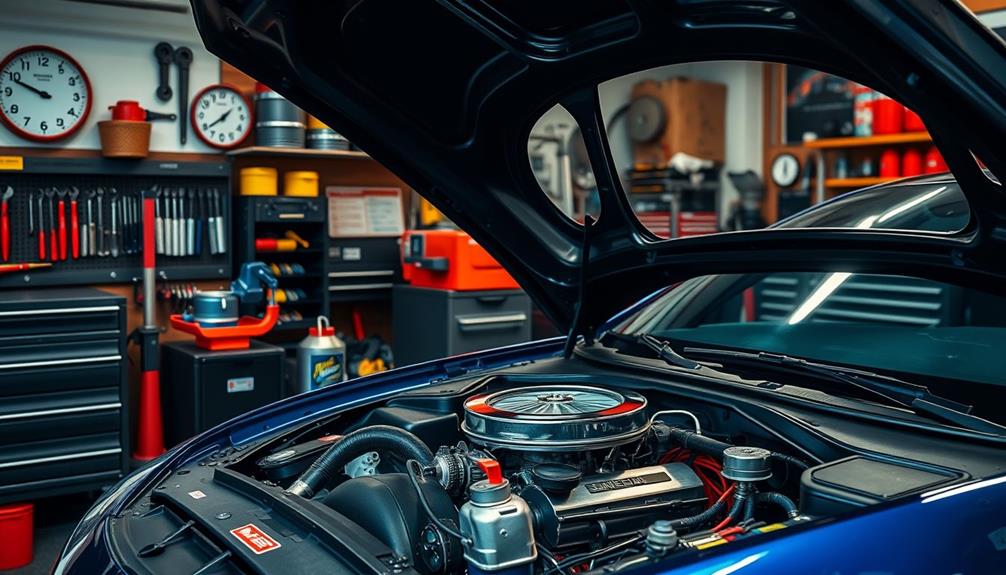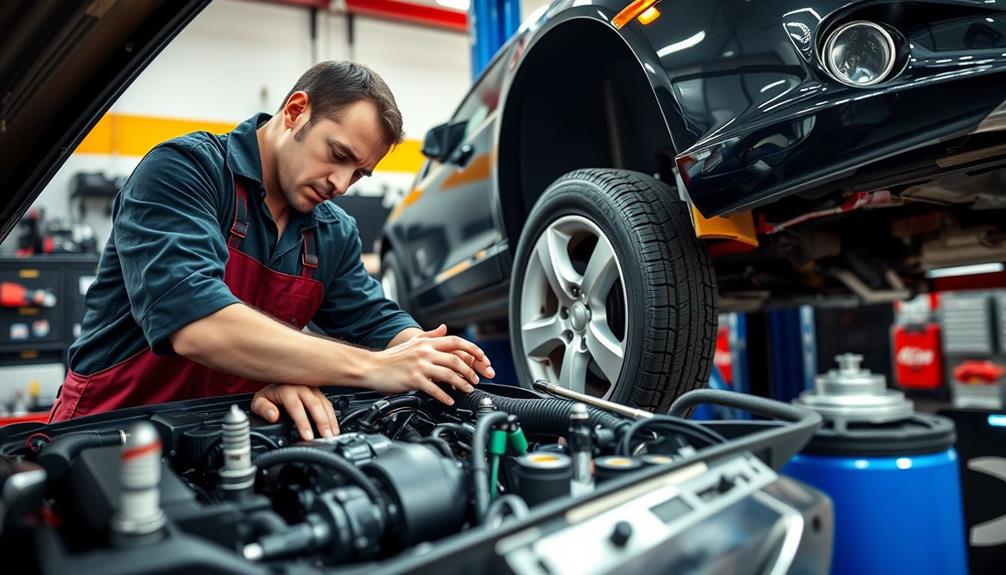To stop brake fade permanently, start by safely lifting your vehicle and removing the wheels to inspect the calipers, pads, and rotors. Replace worn pads and warped or rusted rotors, making sure they sit flush against the hub. Use brake grease on contact points and properly seat the new pads. Check your brake fluid and bleed if necessary. If you keep these steps in mind, you’ll guarantee your brakes perform reliably under heavy use.
Key Takeaways
- Regularly inspect and replace worn brake pads and rotors to maintain optimal braking performance and prevent fade.
- Ensure rotors sit flush against the hub and are free of rust or debris before installation.
- Apply high-temperature brake grease to contact points to reduce noise, wear, and brake fade.
- Check and replace contaminated or dark brake fluid to maintain proper brake response.
- Test drive at low speeds after replacement to verify brakes are responsive and functioning correctly.

Replacing brake pads and rotors is a critical maintenance task that guarantees your vehicle stops safely and efficiently. When you do this, you’re not only restoring braking performance but also preventing issues like brake fade, which can occur during heavy or repeated braking. Before you start, it’s important to understand how brake fluid maintenance plays a role in overall brake system health. Old, contaminated brake fluid can lead to spongy brakes or reduced stopping power, making it imperative to bleed and replace it regularly. During your brake job, you might also need to perform caliper repair if you notice sticking or leaking calipers, which can cause uneven brake pad wear or reduced braking efficiency.
Regular brake fluid maintenance and caliper repair ensure safe, efficient braking performance.
Once you’ve safely lifted your vehicle and removed the wheels, you’ll see the brake calipers, pads, and rotors. As you remove the old pads, inspect the calipers for damage or corrosion. If the calipers are sticking or leaking brake fluid, you’ll need to address this with caliper repair or replacement. Proper caliper function is critical because it squeezes the brake pads against the rotor, converting hydraulic pressure into stopping force. If the calipers don’t operate correctly, replacing the pads and rotors won’t deliver lasting results. Also, check the brake fluid reservoir. If the fluid is dark or contaminated, drain and refill it with fresh brake fluid. This step is essential because brake fluid directly affects how well your brakes respond.
With the calipers and brake fluid sorted, you can remove the rotors. Sometimes, rotors are rusted or stuck on the hub, requiring gentle tapping or a rotor puller. When installing the new rotors, ensure they sit flush against the hub to prevent vibrations during braking. Before installing new brake pads, it’s a good idea to apply a light coat of high-temperature brake grease to the contact points to reduce noise and wear. As you press the new pads into place, make sure they are correctly aligned in the calipers. Once everything’s assembled, pump the brake pedal a few times to seat the pads against the rotors properly.
Additionally, understanding the signs of narcissistic behavior in others can help you recognize manipulation or emotional abuse if you encounter such traits in personal relationships, which is especially important when dealing with difficult family dynamics or toxic relationships. Finally, double-check all bolts and fittings, then test drive your vehicle at low speeds to ensure everything is working smoothly. Proper brake fluid maintenance, caliper repair, and timely replacement of pads and rotors are key to stopping brake fade and maintaining safe, reliable braking performance. By staying on top of these maintenance tasks, you’ll keep your brakes responsive and prevent costly repairs down the road.
Frequently Asked Questions
How Often Should Brake Pads and Rotors Be Replaced?
You should replace your brake pads every 25,000 to 70,000 miles, depending on driving habits, and check rotors for signs of wear or warping regularly. Keep an eye on brake fluid levels and quality, as old fluid can affect braking performance. Brake calipers should be inspected during routine maintenance to make certain they’re functioning properly. Regular checks help prevent brake fade and keep your stopping power reliable.
Can I Replace Brake Pads and Rotors Myself?
Imagine you’re back in the 90s, tinkering with your car. Yes, you can replace brake pads and rotors yourself, but it’s not a walk in the park. You’ll need to understand brake fluid systems and caliper repair, plus have the right tools. If you’re comfortable working with mechanics and follow safety procedures, go for it. Otherwise, a professional can guarantee your brakes work perfectly and safely.
What Are Signs of Brake System Failure?
You’ll notice signs of brake system failure if your brake fluid levels drop or if the ABS warning light comes on. Other indicators include a spongy brake pedal, increased stopping distances, or strange noises when braking. If you experience any of these, don’t ignore them. Addressing brake issues promptly helps prevent accidents and guarantees your vehicle stops safely every time you press the pedal.
Are Aftermarket Brake Parts as Reliable as OEM?
While aftermarket brake parts might seem tempting, they often lack the reliability of OEM components. You may notice brake noise or uneven pad bedding if aftermarket parts don’t meet strict standards. OEM parts are designed specifically for your vehicle, guaranteeing consistent performance and safety. Don’t compromise on quality—trust OEM to prevent brake fade and ensure reliable stopping power, especially during critical moments on the road.
How Long Does a Brake Pad and Rotor Replacement Take?
Replacing brake pads and rotors typically takes about 1 to 2 hours, depending on your experience and vehicle type. You’ll need to take into account brake pad materials, as some materials are easier to work with, and rotor design, which can affect installation time. If you’re familiar with the process, you might do it faster, but new or complex rotors could extend the job. Always follow proper safety procedures for a smooth replacement.
Conclusion
Now that you’ve replaced your brake pads and rotors, you’re all set to enjoy safer, smoother stops. Funny how a simple coincidence—the old pads wearing unevenly—led you to this upgrade, saving you from future brake fade. With fresh components, you might find yourself trusting your brakes more than ever, almost like they’re new again. Remember, regular checks keep this coincidence happening, ensuring your brakes stay reliable and fade-free for miles to come.









